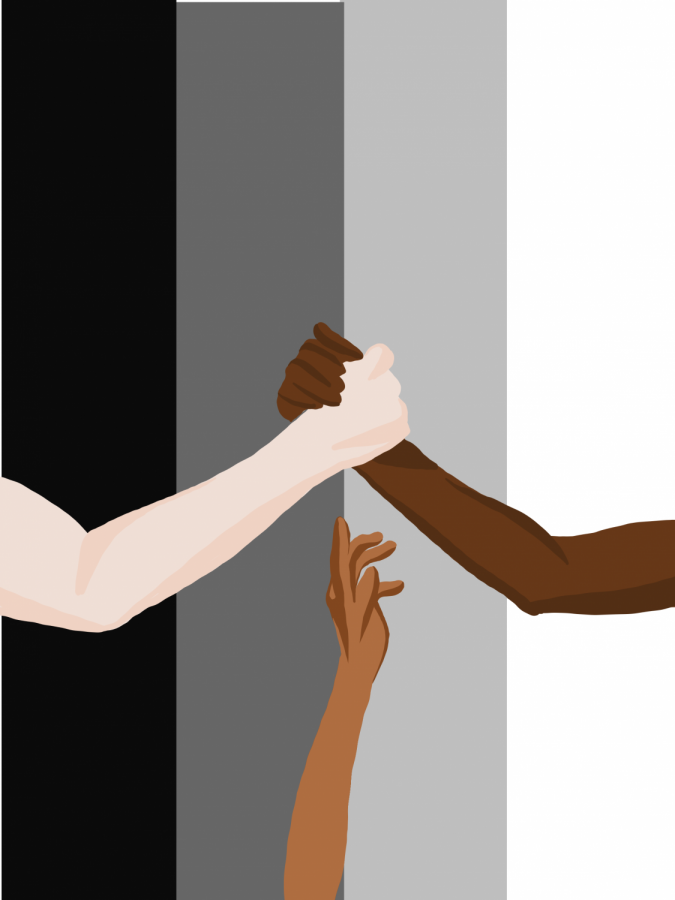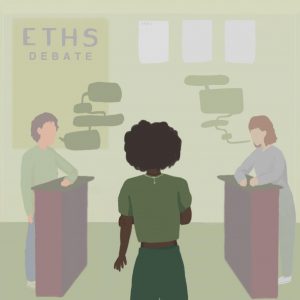Impacts of a racial Black/white binary
February 22, 2021
Contrasts, juxtapositions and general differences are all cornerstones of life and expression; they have been for quite some time. Whether thinking about how a chef will incorporate sweet and salty flavors into their signature dishes or how artists will contrast colors and textures to enliven their work, this reality cannot be denied. Yet, when these forms of differentiation are integrated into people’s identity formation—specifically through binaries—their impacts serve as the foundation for lifelong struggles and questions.
The Cambridge Dictionary defines a binary as “relating to or consisting of two different things, in which everything is either one thing or the other.” Putting this definition into the context of human experiences, it is easy to see how one’s life being defined by only two different possibilities is very problematic and confining.
In this piece, we hope to explore the formation and impacts of a racial Black-white binary with an emphasis on those who often find themselves in the middle of this confusing reality and are, many times, forced by society to “choose a side.” Because of our focus on people with these particular experiences, we want to acknowledge that this piece will not be highlighting the experiences of all Black, Indigenous, People Of Color (BIPOC), and by no means do we want the ideas in this article alone to inform the entirety of our expanding consciousness around race.
To contextualize the racial Black-white binary, we must look to our past and understand that it is a product of anti-Blackness and the ways in which Black people have been commodified both physically and emotionally in order to uplift white supremacy. These actions have given power to white people and have facilitated society’s understanding of Black and white as the only two predominant races. Thus, many people—including brown people—have come to comprehend their own racial identities through comparison to only Black and white identities. This Black-white binary has created a world where the extent to which every person feels that they can exist with rights and privileges varies greatly.
Adrian’s Experience
To my friends, I am brown. To the stranger I pass on the street, I am brown. For some reason, however, to the U.S government, I am white. This dynamic has always been of interest to me. Being born to Persian parents, I greatly wondered about a concrete connection between being Middle Eastern yet being considered white. I thought about the empires that ruled the Middle East long ago, the Persian Empire until being defeated by the Greeks. One could even spar a little more recently to the Ottoman Empire, followers of Islam who were powers in the Middle East and tried to gain traction in Europe. Upon further investigation, to the white empires and countries of Europe, it could be greatly argued that both the Persian and Ottoman empires were looked at as minorities or ‘not of our kind’ by the European giants. Whether the motive was the different practice of religion or the color of the skin, the being different dynamic was there. What came to be for a large group of brown people to be considered white? What is the impact it carries on the brown community being underrepresented?
Meena’s Experience
It was not until fairly recently that I asked my father for a more detailed account of why my ancestors emigrated from India to Kenya and some generations later made it to the United States. In short, his recounting revealed that what ultimately drove my family out of India was a severe lack of economic opportunities and civil rights, a result of the British occupation, and that they eventually got to Kenya upon hearing that Indians were being recruited to work on the British East Africa Railroad. I envisioned the despair and hopelessness that undeniably permeated the lives of Indians under the white rule, and wondered if these emotions faded in Kenya, a place where anti-Blackness came into play and Indians found themselves in the middle of a Black-white dynamic.
This story only increased my curiosity, not just with my family’s history, but with the experiences of brown people everywhere, including myself. In being left out of so many contemporary conversations about race, I have found my reality and my identity to be incredibly confusing. To better make sense of my experiences and those of other brown people, I wonder: how have brown people historically navigated a world in which a Black-white binary is deeply embedded? And, how can we resist this reality in order to get rid of the harm it is doing to all BIPOC?
Turning to others
Brown experiences in this world are not homogenous, so to answer the questions both of us have posed, we opened the floor to many who have grappled with their identities.
As mentioned earlier, individuals who do not find themselves seen within the dominant Black-white narrative are often urged to make sense of their racial identities by comparing them to both whiteness and Blackness.
“My experience in relationship to whiteness has been ‘You need to be like this, but you will never be this,’ and my relation to Blackness is being taught that you need to distance yourself from that to become like a white person,” community service coordinator Diana Balitaan says.
Although these are the messages that many brown people find themselves enveloped in and forced to navigate, society often dictates when we have access to power and privilege and when we do not.
“In one community, my uncle and aunts got denied housing, but they didn’t in another place because they saw us as professionals and people who were closer to whiteness,” Balitaan explains.
Through society’s promotion of compartmentalized identities, not only do people feel they have to engage in a delicate dance between two races, but they also come to understand what each side of the binary represents: whiteness being admirable and Blackness being something to avoid.
Due to these harmful notions that people have only begun to disrupt, many find themselves compelled to adhere to strict standards to eventually “make it” in the world.
“My family always told me to keep my head down, work hard and earn my privilege. And this didn’t happen by speaking up, it happened by shutting up—whatever harmful things they say, in one ear, out the other,” English teacher Anita Bucio explains.
The experience Bucio recalls is common and has certainly contributed to a major stereotype about people of color, specifically East, Southeast and South Asian-Americans who are viewed as model minorities, and quiet people who “stay in their lanes.”
While it is important to recognize that this stereotype is harmful towards brown people, it is also vital to see that conforming to this stereotype is harming others.
“I think there is a lot of harm in being a model minority that is placed on us, but then harm that we do in the cultural norms and the denial of our privilege,” Bucio says.
English teacher Angela Sangha-Gadsden expands on this idea.
“I have to acknowledge that my freedoms as a dark-skin, Indian woman really come from the plight that African-Americans go through. I am always really aware of how Asian Indians have been able to come into a space and climb the social class ladder, whereas Black people and people who are Indigenous to this land and experienced genocide aren’t able to experience certain privileges,” Sangha-Gadsden explains.
The notion of privilege Sangha-Gadsden describes comes in a form of a teeter-totter. As brown people, we recognize that our place in society carries some privilege, however, it is important to gain perspective of the discomfort people in the brown community may face, in relation to the smaller population of the community in the U.S.
“I walk into my school’s cafeteria. The first thing I do is look for someone who looks like me. I try to blend in, but I’m always subconsciously aware of the fact that I’m different. I’m brown after all,” class of 2019 graduate Abraham Abraham says.
There are numerous complexities within the binary conversation, one being the number of brown ethnic groups considered ‘white’ by the U.S government—specifically, people of Middle Eastern descent. A large percentage of the brown population in the U.S. belong to these underrepresented ethnic groups yet are labeled as white. An added racial box will better represent the brown community as a whole, giving reassurance of recognizing true identity.
Beginning to Draw Conclusions
As proven in the aforementioned quotes, the experiences of brown people are diverse and complex, thus it is hard to draw concrete conclusions regarding how to navigate and eradicate a Black-white binary, but a few things do become clear.
The impact of what binaries mean in society and how brown people fit into them will always be a spark for further action. When reflecting upon the past of the Evanstonian in relation to brown people, the blatant underrepresentation of our communities can promote the understanding of Evanston as only a Black and white place. However, brown people are here, and we always have been. Our racialized realities define the way we engage with the Evanston community and how Evanston engages with us. By acknowledging brown existence in consideration of our experiences rather than constantly defining them by our proximity to whiteness and Blackness, our identities can be more appropriately included.
In addition to this, for society to feel better for all people, it is important to consider what it would take for brown people to reclaim our agency while simultaneously addressing issues within our communities—especially anti-Blackness—to unify with others.
“I think not focusing on BIPOC in general but acknowledging all of our identities and figuring out how to bring those people together is important,” senior Sylvia Tellez says.
Bringing people together with the intent of healing and creating community seems to consistently come up in conversations around progressing towards a liberating future.
Balitaan adds to this sentiment.
“Understanding what we deserve as people—what would it mean if we were ultimately treated with love and respect?”












